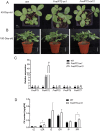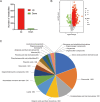Overexpression of housekeeping gene FveIPT2 enhances anthocyanin and terpenoid accumulation in strawberry fruits with minimal impact on plant growth and development
- PMID: 40677761
- PMCID: PMC12268167
- DOI: 10.1093/hr/uhaf130
Overexpression of housekeeping gene FveIPT2 enhances anthocyanin and terpenoid accumulation in strawberry fruits with minimal impact on plant growth and development
Abstract
Anthocyanins and terpenoids are secondary metabolites with well-documented health benefits. Isopentenyl transferases (IPTs) are key enzymes in cytokinin (CK) biosynthesis. While ADP/ATP-type IPTs and their associated trans-zeatin (tZ)-CKs and iP-CKs are considered to play regulatory roles in growth and development, as well as stress acclimation in plants, tRNA-type IPTs and cis-zeatin CKs (cZ-CKs), which may serve housekeeping functions, remain less studied. In this study, the tRNA-type IPT gene FveIPT2 was overexpressed in woodland strawberries (Fragaria vesca). Overexpression had minimal impact on plant growth and CK levels but resulted in transgenic fruits exhibiting a significant increase in total phenolic, flavonoid, and anthocyanin contents, indicating enhanced fruit quality. Metabolite profiling revealed substantial increases in nine specific anthocyanins and 24 out of 47 detected terpenoids in the transgenic fruits. Real-time quantitative polymerase chain reaction (RT-qPCR) analysis confirmed the upregulation of genes involved in anthocyanin and terpenoid biosynthesis and transport. These findings demonstrate that while tRNA-type IPTs may primarily play housekeeping roles, FveIPT2 overexpression can significantly enhance fruit quality by boosting terpenoid and anthocyanin accumulation, highlighting the unexpected potential of these genes to improve the nutritional value of edible fruits.
© The Author(s) 2025. Published by Oxford University Press on behalf of Nanjing Agricultural University.
Conflict of interest statement
The authors declare no competing financial interests in this manuscript.
Figures






Similar articles
-
Unraveling the proteomic landscape of red-fleshed apples to identify regulators of anthocyanin accumulation.J Proteomics. 2025 Aug 15;319:105470. doi: 10.1016/j.jprot.2025.105470. Epub 2025 Jun 3. J Proteomics. 2025. PMID: 40472891
-
Effects of different hormones on the color of tree peony leaves.BMC Plant Biol. 2025 Jul 2;25(1):822. doi: 10.1186/s12870-025-06837-8. BMC Plant Biol. 2025. PMID: 40604434 Free PMC article.
-
The Black Book of Psychotropic Dosing and Monitoring.Psychopharmacol Bull. 2024 Jul 8;54(3):8-59. Psychopharmacol Bull. 2024. PMID: 38993656 Free PMC article. Review.
-
Management of urinary stones by experts in stone disease (ESD 2025).Arch Ital Urol Androl. 2025 Jun 30;97(2):14085. doi: 10.4081/aiua.2025.14085. Epub 2025 Jun 30. Arch Ital Urol Androl. 2025. PMID: 40583613 Review.
-
Sexual Harassment and Prevention Training.2024 Mar 29. In: StatPearls [Internet]. Treasure Island (FL): StatPearls Publishing; 2025 Jan–. 2024 Mar 29. In: StatPearls [Internet]. Treasure Island (FL): StatPearls Publishing; 2025 Jan–. PMID: 36508513 Free Books & Documents.
References
LinkOut - more resources
Full Text Sources
Research Materials

